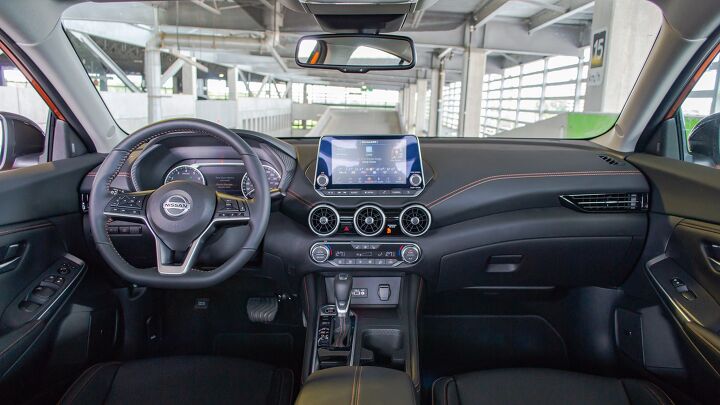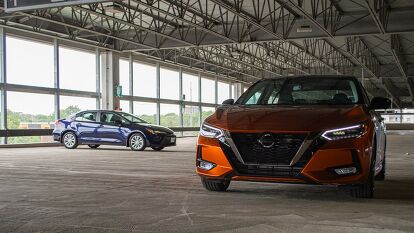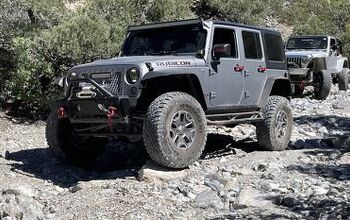Toyota Corolla LE Vs Nissan Sentra SR Comparison


So you’ve been called back to the office.
It’s not a full five-days-a-week expectation anymore, which is good, since you moved further out of town. You need a sensible set of wheels, whether it’s to brave downtown, or even just shoot over to the nearby train station.
There are few cars more sensible than the Toyota Corolla. The perennial best-seller saw a useful round of updates for this year. The bulk of the changes focused on the empowered hybrid and it gaining AWD—to say nothing of the riotous GR Corolla. But the humble LE saw a big improvement too, gaining the more powerful and more efficient 2.0-liter engine found elsewhere in the lineup. It also saw a huge infotainment improvement, which should make those early morning commutes easier.
Facing off against the Toyota is the Nissan Sentra. It hasn’t had its mid-cycle update—that arrives for 2024, so soon—but continues to offer lots of content at an affordable price, wrapped up in attractive sheetmetal. And we were overdue for a revisit. Managing editor Mike Schlee and I spent a week with both cars to determine which we’d commute in.
Interior and Cargo Space

Toyota Corolla: The Corolla cabin is a familiar one, especially since we spent time in an LE (hybrid) just two months ago for a different comparison. It’s the same story here: a big, bulbous plastic dashboard draws attention first. Not so much because it’s stylish or attractive, but because there’s just so much of it. A ring of piano black surrounds the base of the central touchscreen, keeping all the important climate controls close, but as fairly fiddly small buttons. Fit and finish is solid, and while the Toyota’s material quality is a definite step down from that of the Civic and Mazda3, the Corolla cabin feels like it’ll last approximately forever.
The quilted cloth seats are typical Toyota squishy, offering up good long-distance comfort but fully manual adjustments. While that previous LE had a full tin-top, this one gains a moonroof. With 38.0 inches (965 millimeters) of headroom it’s only a 0.3-in (8-mm) penalty, and rear passengers enjoy the same 37.1 inches (942 mm) of the stuff either way. The Corolla’s second row is a mixed bag: we like the supportive seats themselves, but the legroom is merely okay at 34.8 inches (884 mm). Ingress and egress are also just a bit worse than in the Santa.
The Corolla offers up 13.1 cubic feet (371 liters) of trunk space, and a 60/40-folding rear bench.

Nissan Sentra: Even if it’s also a predominantly black cabin, the Sentra’s interior is more daring and appealing here. The dual-wing dashboard design and its trio of round climate vents sets a sportier tone, with the orange contrasting stitching providing a much-welcome splash of color. The flat-bottomed leather steering wheel feels good in the hands, plus the chrome-lined dials ahead look great and are highly legible. The low-slung shape of the Sentra does impact outward visibility, however. We prefer the Sentra’s larger climate controls, too. Material quality covers a wider spread: the wheel might feel great, but Nissan’s faux-carbon trim bits ain’t fooling’ anyone. And the door panels, specifically the rears, feel cost-cutted too far.
We have no such complaints with the faux-leather seating. Well contoured with excellent thigh support, the Sentra’s thrones keep numb butts away. That you also get power adjustability for the driver’s seat is a big plus, too. The Nissan gives up a half-inch of headroom compared to the Toyota; that’s entirely due to the moonroof, as it costs 1.4 inches (47 mm). It’s a similar measurement penalty in the back, and legroom is just slightly better than the Toyota, at 34.9 in (888 mm). The rear seats themselves are also comfier, though the kicked-up window line does make it feel a little tighter.
The Sentra’s enormous trunk can swallow up to 14.3 cubic feet (405 L) of your stuff.
Bottom Line: The Sentra’s more interesting cabin design and better seating give it an early edge. Taller folks may prefer the extra noggin space in the Corolla, though.
Toyota Corolla vs Nissan Sentra: Tech and Features

Corolla: Goodbye, Entune. The ’23 ‘Rolla brought the latest Toyota infotainment system with it, and it’s a huge step up. The screen is bright and sharp, and response times are quick. Wireless Apple CarPlay and Android Auto are still relative rarities in this segment, too.
That’s about all you can expect at this humble trim level, however. The Corolla’s cloth seats are fully manual adjustable, and while our Can-spec tester has heated front seats, that’s not the case in the US. There’s no heated steering wheel, either. The six-speaker sound system is only okay. Props to Toyota for offering the (optional) wireless charge pad on a lower trim, however. It works well enough, and means not having to hunt for the oddly-placed front USB port on the dashboard underside.
Toyota Safety Sense 3.0 is a great, comprehensive suite of driver assists standard on all 2023 Corollas. This one augments the automated emergency braking, lane assists, and adaptive cruise control with blind-spot monitoring and rear cross-traffic alert.

Sentra: On the infotainment front, the Sentra’s 8.0-inch screen is … fine. It’s straightforward in operation, but suffers from outdated visuals and laggy responses. Phone pairing is wired, and you won’t find a wireless charge point here. The Nissan counters with the better sound system (eight speakers!), heated front seats, and a power-adjustable driver’s seat.
The Nissan matches the Toyota on the safety front, including all the modern driver assists we expect. It goes one further by adding a 360-degree camera, a feature that’s still rare on SUVs costing almost twice this.
Bottom Line: The Sentra has the edge in safety, while the Corolla beats it for infotainment. So it’s a draw, then.
Powertrain, Driving Feel, and Efficiency

Corolla: Moving up to the 2.0-liter engine for 2023 is a win-win situation for the Corolla LE. The 169 horsepower and 151 pound-feet make it … well, not quick, but quicker than most in the class. Toyota’s clever CVT also includes a physical first gear for smoother take-offs, avoiding some of the awkwardness that the Nissan can experience from the lights. Plus, the package is more efficient than the ancient previous 1.8-liter, capable of a consistent 35 mpg (6.7 L/100 km) in combined driving.
Rolling on modest 16-inch alloys and 205-section rubber, the Corolla prioritizes comfort over excitement—as it should. Even if you do want to have a bit of fun, the LE isn’t as poised as it once was. Toyota quietly swapped in a torsion beam rear suspension to the lower trims this year, similar to the setup found in front-drive Corolla Cross models. It’s ever so slightly harsher over bumps in the city, and there’s more audible expansion joint thwaps, but it’s fine for what is, at the end of the day, a commuter car. The steering is easy-peasy light, but then, so is the Corolla itself, so it’s consistent and stress-free. Brake feel is smooth and progressive.

Sentra: The Sentra is also part of the 2.0-liter nat-asp club. This one puts out 149 hp and 146 lb-ft; not a noticeable gap in the city, but makes for more prolonged on-ramps and passing. As mentioned above, the CVT can’t match the refinement of the Toyota unit. It still has good manners, mind you, keeping the revs nice and low unless you’ve introduced pedal to floor.
Despite the power deficit, the Sentra doesn’t hold an economy advantage over the Corolla. The base-model S comes close at 29 mpg city, 39 mpg highway, and 33 mpg combined. (Canadian figures: 8.0, 6.0, and 7.1 L/100 km, respectively.) This SR Premium rides on pretty 18-inch alloys though, and that shaves 1 mpg off the city and combined figures, plus 2 mpg off the highway figure.
In a bit of a role-reversal, the big news for this Sentra generation was ditching a torsion-beam setup for a multi-link rear. The compact Nissan oozes big-car feel, all relaxed responses—and more pronounced edge on bumps from that large rolling stock. The Sentra just sort of exists; not especially comfortable, but not exciting either.
Bottom Line: We lean Corolla here: the drivetrain is both more flexible and more efficient, and the comfort-oriented ride is our sort of vibe.
Toyota Corolla vs Nissan Sentra: Styling

Corolla: It’s a Corolla. You’ve seen it thousands of times, possibly even already today. The sedan saw the most subtle of facelifts for this year, keeping the sharp, arrow-shaped headlights and large lower intake. There’s minimal fuss along the flanks, and moving around to the back, a pair of clean taillights are connected by a thin strip of black plastic. The LE features a large swath of matte black plastic in the rear bumper, reminding you that yes, this isn’t a top trim.

Sentra: The last Sentra was not pretty. But Nissan sent it to the gym, stretching the length and chopping the height for much-improved proportions. In came wider headlights and a V-motion grille, plus pretty 18-inch wheels—sadly coated in black here. A smart kick-up in the window line is accentuated by the two-tone roof treatment. Around back, angular taillights wrap up a smart, handsome package.
Bottom Line: I’m drawing a line in the sand: the Sentra might be the best-looking compact sedan currently on sale.
Pricing and Value:
Corolla: American buyers can’t quite match our Can-spec LE Upgrade tester. The real miss are the front heated seats, which only unlock on the XSE in gas-powered Corolla-land. Canada: it tends to be cold. Beyond that, a roughly equivalent LE with the Premium package is $24,985, including destination.
In Canada, the Corolla LE Upgrade lists for $27,500 CAD, including destination.
Sentra: Buying the top-shelf Sentra will cost American buyers $26,655, including destination and the Premium Package. The two-tone paint is an additional $645, and the black alloys are a $785 uncharge.
This Canadian-spec tester is the top-level SR Premium, which retails for $30,578 CAD up north. The only additional cost there is the two-tone paint; the alloys are rolled into the Premium pack north of the border.
Bottom Line: The Sentra’s extra cost is easier to justify in the US: $1,600 for front heated seats (plus driver’s power-adjustability), a 360-degree camera, and other niceties ain’t bad. The three-grand gap between them is a tougher sell in Canada, where you could easily swing a higher-spec Corolla or even a hybrid, assuming it’s available at your local dealer. You’d still miss the around-view camera, though. The Corolla just noses ahead here.
Toyota Corolla vs Nissan Sentra Comparison: Verdict

This was a close one. The Sentra is our heart-over-head choice: more attractive and better equipped, it wins the better-first-impression race. The ride and space are only meh, though, and the drivetrain is definitely feeling its age.
If we’re getting called back to the office and need to pick between these two, it’s Corolla time. The better drivetrain, gas savings, and comfort-oriented ride are its major advantages. We also appreciate its tech suite; a slightly worse stereo is worth the wireless pairing and charging.
Become an AutoGuide insider. Get the latest from the automotive world first by subscribing to our newsletter here.

Kyle began his automotive obsession before he even started school, courtesy of a remote control Porsche and various LEGO sets. He later studied advertising and graphic design at Humber College, which led him to writing about cars (both real and digital). He is now a proud member of the Automobile Journalists Association of Canada (AJAC), where he was the Journalist of the Year runner-up for 2021.
More by Kyle Patrick


























































































Comments
Join the conversation
Sentra is more attractive? Boy do you guys need new glasses. Nissan is not known for style and that boring thing does not stand out as such. Toyota all the way